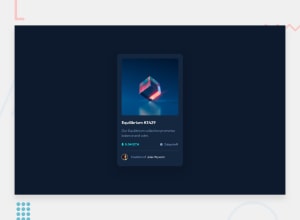
Submitted over 2 years ago
nft preview card using HTML and CSS.
@mouhibeddine
Design comparison
SolutionDesign
Solution retrospective
1- Any notes on how can I improve my code 2- I think I could've done this in an easier way so any suggestions?
Community feedback
- @PhoenixDev22Posted over 2 years ago
Hello Mouhib Eddine Zakaria,
Congratulation on completing this challenge. Excellent work! I have few suggestions regarding your solution, if you don't mind:
HTML
- The most important part in this challengeinteractive elements. Since there's a :hover state on the image and means it's interactive, So there should be an interactive element around it. When you create a component that could be interacted with a user , always remember to include interactive elements like(button, textarea,input, ..)
for this imagine what would happen when you click on the image, there are two possible ways:
1: If clicking the image would show a popup where the user can see the full NFT, here you use<button>. 2:If clicking the image would navigate the user to another page to see the NFT, here you can use<a>.
For the same reason, use
<a>to wrapEquilibrium #3429 and Jules Wyvern.- The link wrapping the equilibrium image should either have
Sr-onlytext, anaria-labeloralttext that says where that link takes you.
- For any decorative images, each img tag should have empty
alt=""and addaria-hidden="true"attributes to make all web assistive technologies such as screen reader ignore those images in( icon-ethereum, icon-clock ).
- Profile images like that avatar are valuable content. The alternate text of the avatar’s image should not be
empty. You can use the creator's nameJules Wyvern. Read more how to write an alt text
- If you wish to draw a horizontal line, you should do so using appropriate CSS. You may remove the
<hr>, you can useborder-top:to the avatar's part.
- For middle part of the card
class="details", you can use an unordered list<ul>, in each<li>there should be<img>and<p>. That way you can align them centrally.
- There are so many ways to do the hover effect on the image, The one I would use is pseudo elements
::before, ::after. You can use pseudo-elements to change the teal background color to hsla. Then the opacity can be changed from 0 to 1 on the pseudo element on the hover. Also using pseudo elements makes your HTML more cleaner as there's no need for extra clutter in the HTML. The icon view doesn’t really need to be in the HTML. You can use CSS for it.
- Consider Indenting your code consistently. It makes it really hard to read and find bugs like this. Your code editor can even do this formatting automatically for you.
Overall, Your solution looks great. Hopefully this feedback helps.
Marked as helpful1@mouhibeddinePosted over 2 years ago@PhoenixDev22 thank you i appreciate your feedback!
1@PhoenixDev22Posted over 2 years ago@mouhibeddine You're welcome and glad to help.
Marked as helpful0 - The most important part in this challengeinteractive elements. Since there's a :hover state on the image and means it's interactive, So there should be an interactive element around it. When you create a component that could be interacted with a user , always remember to include interactive elements like(button, textarea,input, ..)
for this imagine what would happen when you click on the image, there are two possible ways:
Please log in to post a comment
Log in with GitHubJoin our Discord community
Join thousands of Frontend Mentor community members taking the challenges, sharing resources, helping each other, and chatting about all things front-end!
Join our Discord
